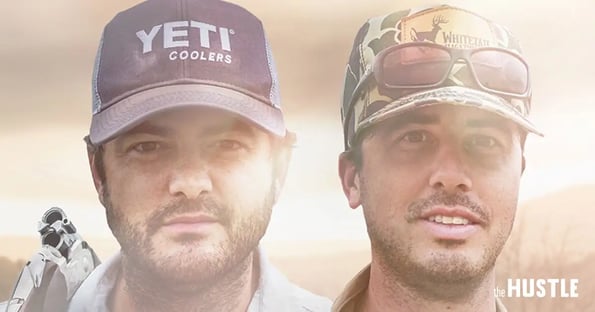A few weeks ago I was in Texas for a wedding. Somewhere between Houston and San Antonio, we passed a truck on the highway with a “YETI” sticker on the back window. Big white sans-serif text, nothing else in terms of explanation.

Didn’t think much of it, but then, after seeing it for a third time in under an hour, I finally had to ask my buddy what it was about. According to him, it’s a company based out of Austin that sells coolers for $300+ each and they’ve been absolutely crushing it over the past few years. Turns out I accidentally opened a proverbial can of worms because the next 15 minutes was a nonstop, increasingly excited explanation about how the coolers can withstand a grizzly bear attack, how owners have competitions on how long they can keep ice cold, and why anyone who wants to be a legit outdoorsman is required to have a YETI.
Dude, relax. You’re about to have an aneurysm talking about a freakin’ cooler that looks straight out of Duck Dynasty. What makes it so special? How is this company able to convince grown men to wet their pants over 33° Fahrenheit?
How were they able to turn a commodity into a luxury item that pulls $450m in sales? It’s an incredible story of branding, community, and passion and one that makes entrepreneurs and product designers drool with envy.
The beginning
YETI Coolers was founded in 2006 by two Texan brothers, Roy and Ryan Seiders, who wanted a higher-quality cooler than the $30-40 options at the big box stores. They needed something that was durable and kept their beer cold for a week rather than a day.
At a boating tradeshow, Ryan found an imported, rotomolded cooler that was almost exactly the quality they were looking for, minus the design, finish, and commercial appeal. Clearly there was an opportunity and the brothers started distributing the coolers for the Thai manufacturer.
Soon after, the pair made a trip to Southeast Asia where they found a manufacturer in the Philippines that was willing and able to build the exact product they wanted.
Growing like crazy
Because they were building an expensive cooler, they needed an expensive price tag. That meant dominating the high-end cooler market which, frankly, wasn’t really a thing at the time.
Think about that. YETI coolers started at $300 and they were in direct competition with $30 coolers that had a $5 margin. Because they were doing the opposite of what everyone else in the industry was doing, the brothers knew they had to absolutely nail their customer. In this case, that meant going after hardcore outdoorsmen whose lives revolved around fishing and hunting. People like themselves.
And from day one they lived and breathed their brand. Every cooler ordered in the first 3 years came with a YETI hat and t-shirt. Customers were educated on selling points to the extent where they could passionately defend the product to the inevitable naysayers who saw it as an unnecessary luxury.
Slowly but surely momentum started to build and by 2011, 6 years after they started, the company hit $29m in revenue. By 2014 that figure grew to $147m and just a year later they were pushing $450m.
That’s a 15x growth in just 4 years mostly thanks to the grassroots marketing of hunters and fishermen who got the word out. Talk about a powerful community… just look at some of the forums. For every naysayer claiming it’s just overpriced marketing there’s someone who bleeds YETI and comes to their defense, telling their own version of how they did something outdoorsy and saved ice.

Source: in-depthoutdoors.com

Source: tigerdroppings.com

Source: thehulltruth.com/
Heck, there’s even an Instagram account, @yeti_butts_usa, dedicated to girls in swimsuits sitting on YETI coolers. Obviously it’s not safe for work but we both know you’re clicking anyway. Good luck copying that one, Igloo.
Takeaways
YETI is the perfect example of a company going brand-first. Everything they create builds community and showcases why they exist: to hunt, fish, and be outdoors. Anyone who identifies with that can’t help but behind the company’s mission and, as a result, is willing to shell out big bucks for whatever they make. That’s why they can get away with selling premium stuff like a $20 bottle opener that people absolutely love.
Seriously, look at some of the reviews.
This brand-first strategy isn’t anything new, just look at companies like Harley-Davidson and Red Bull. They aren’t just selling a physical product, they’re selling a way of life. Are you stuck at a white-collar job and need an escape on the weekend? Get a Harley, join the club, and get on the open road. Are you into adventure sports? Make sure to grab a Red Bull so you have the energy.
Idea brands like this are incredibly powerful for selling product, building community, and generating word of mouth marketing. And, as it turns out, content generation is one of the most effective ways to stoke this type of fire.
That’s why YETI coolers started producing really high-quality, 5-minute movies and blog posts all about rugged badasses and craftsmen, largely centered around hunting and fishing but by no means limited. No mentions of coolers, just an appreciation of hard work. Here’s my favorite, written by Aaron Franklin about the legendary Texas pitmaster, Tootsie, from Snow’s BBQ.
For YETI, they’ve found the unquestionably profitable combination of a great product (coolers that will keep ice longer than all others), an incomparable brand (both Igloo and Cabela’s have similar coolers but nowhere near the success), and a passionate community.
Still don’t know what I’m talking about? Just check out Chris Janson’s title track from his debut album that reached #8 on Billboard’s Hot Country Songs for 2015.
